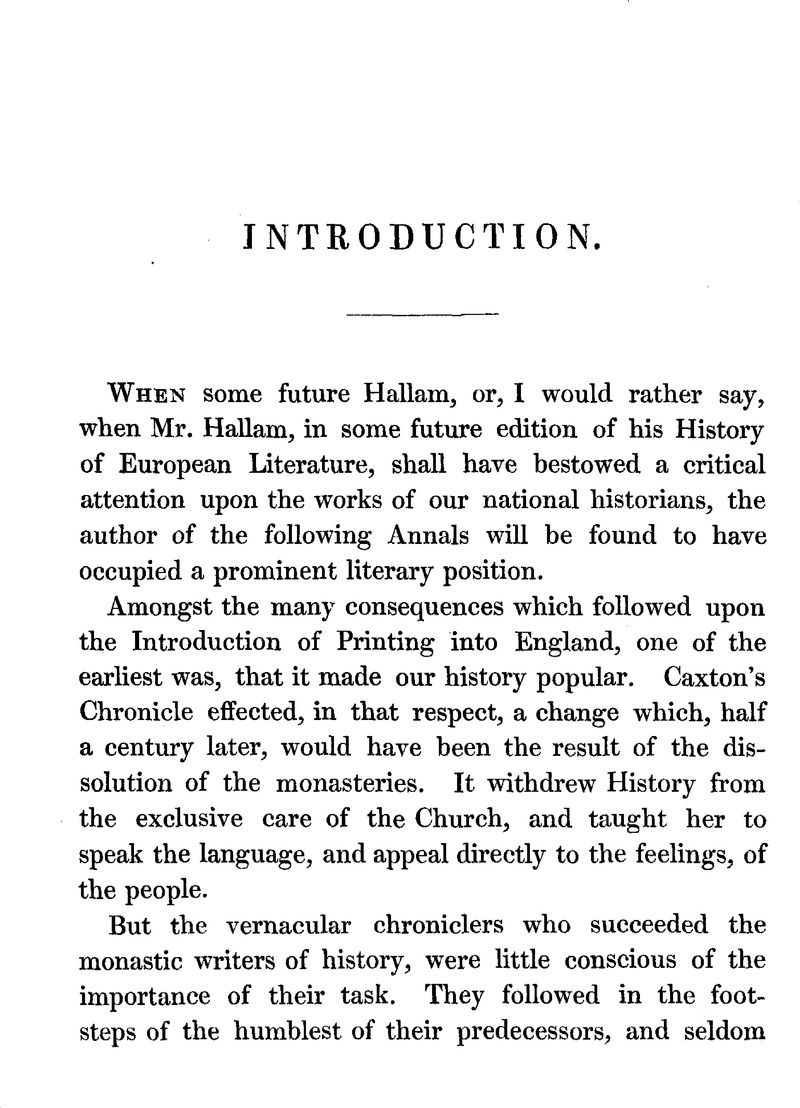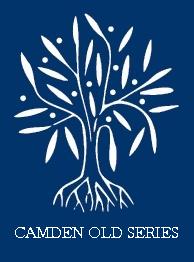No CrossRef data available.
Article contents
Abstract

- Type
- Introduction
- Information
- Copyright
- Copyright © Royal Historical Society 1839
References
page vii note * Hayward's feeling of respect for the authors of antiquity is strongly expressed in the following passage in his “David's Teares :” —” The rich compositions of ancient times I reverence and admire; they do not only satisfie but astonish mee. I see them not to the depth, but I see them so farre, that I conceive the farthest reach of our age cannot neerely approach them. Of my own productions, never any did fully content mee, and the approbation of others is no warrant to my own judgment—tender and severe in what I doe,”
page viii note * There is a coat of arms—argent gutté, a fesse nebulé gules—in the right-hand upper corner of Hayward's engraved portrait, inserted in his Edward VI., edition 1630, but I have not been able to find any authority for rightly attributing those arms either to Hayward or any one else. They do not seem to have been recognised as belonging to Hayward by the College of Arms, for there is a blank shield in the place usually occupied by the arms in the Book which contains the certificate of his burial : vide post, p. xlvii.
page ix note * I state this fact upon the authority of all the biographical writers who have made mention of Hayward, with the addition, also, of Cole, the Cambridge Antiquary (Addit. MS. 5871) ; but I must add that Hayward's name does not occur in the transcript from the Register amongst the Baker MSS. (Harleian MS. 7038), and J. O. Halliwell, Esq. of Jesus College, having, very kindly, done me the favour to make a search at Cambridge, has not been able to find the date of Hayward's degree there.
page x note * “Homines male feriati Essexium ubique per circulos, et ministri quidam etiam è suggestu, immodicis laudibus extulerunt.” Annales, ii. 185, edit. 1627.
page x note † The work bears date in 1599, and was no doubt published after the 28th September in that year, the day of Essex's arrival at the palace of Nonesuch on his return from Ireland, as the very full enumeration of his titles does not include that of Lord Deputy of that country. The full title of this and of all Hayward's other works will be found in the Catalogue which I have appended to this Introduction.
page xii note * Works, vi. 265, Montagu's edition.
page xii note † He procured “an old play “founded upon “the deposing of Richard II.,” to be played on the afternoon before their breaking out into rebellion, and he, and a great company, attended the performance ; see the circumstances related in Camden's Annals, anno 1601; Bacon's Works, vi. 363, Montagu's edition; State Trials, i. 1412. What “old play “it was that Sir Gilly Merick revived is a moot point amongst Shakspeare critics and commentators, the solution of which has been rendered more difficult by Mr. Collier's interesting publication of the notes of Forman, the astrologer, in his “New Particulars regarding the works of Shakespeare, 8vo. 1836.” Forman gives clear testimony to the existence of a play entitled Richard If., which differed both from Shakspeare's play of that name, and also from that ordered to be played by Merick. Mr. Collier's book contains all the facts, together with a very ingenious letter from Mr. Amyot, in which he suggests various reasons for believing that Shakspeare wrote a “First Part of Richard II.,” and that that First Part was the play which Forman saw; see also the Introduction to Richard II. in the Pictorial Edition of Shakspeare.
The notion of the applicability of the precedent of Richard II. to the case of all weak and erring sovereigns, occasioned a republication of Hayward's Henry IV. in 1642.
page xiv note * Bacon's Works, vi. 259, Montagu's edition.
page xiv note * Camden's Annals, anno 1601. Upon reference to the Books of the Privy Council—which was kindly permitted by C. C. Greville, Esq.—with a view of procuring some further information respecting Hayward's imprisonment, an entry was found, under the date of the. 17th May, 1600, which purports that a person of the same name, but described as of the Inner Temple, was summoned before the Lords at that time, and bound to give attendance to answer whatever might be objected against him. Upon further inquiry I found that the John Hayward to whom that entry refers was, at one time, of Clifford's Inn, and afterwards of Tandridge, in Surrey; that he was admitted of the Inner Temple on 22nd November, 1588, and was called to the bar on the 3rd November, 1598. The entry in question rather puzzled me at first, and I mention these facts lest any future inquirer should be misled by it. The same person is mentioned as John Howard in Manning and Bray's Surrey, ii. 305, 379.
page xv note * The Right of Succession asserted against the false Reasonings and seditious Insinuations of R. Dollman, alias Parsons, and others. 4to. London, 1603.
page xv note † A Treatise of Union of England and Scotland. 4to. London, 1604.
page xvii note * Harl. MS. 292, fo. 128.
page xxi note * This was in September, 1612; which is the date, therefore, of the composition of the following Annals.
page xiii note * Coote's Catalogue of English Civilians, p. 73.
page xiii note † There were two other Doctors of Laws knighted on the same day, Sir John Amie and Sir James Hussey. The latter was registrar of the University of Oxford, principal of Magdalen-Hall, and Chancellor of Sarum. He was admitted of Doctors’ Commons on 28th January, 1604. Coote's Cat. p. 68.
page xiii note ‡ Wood's Fasti Oxon. i. 368.
page xxiv note * The words within brackets are derived from an interleaved copy of this work in the British Museum, which contains those and various other passages, inserted in a handwriting which, judging from comparison, I believe to be that of Hayward himself.
page xxviii note * Vide Nicolson's Historical Library, p. 87, edit. 1736, and Brydges's Censura Literaria, iii. 43, n.
page xxix note * Lansd. MS. No. 142, fo. 418.
page xxix note † Ibid. fo. 414 ; fo. 416.
page xxx note * I look upon this paper as an unquestionable specimen of Hayward's handwriting, and it is from comparison with it that I have concluded that the MS. notes in the copy of the treatise on Supremacy before mentioned (p. xxiv, n.), were also written by him. The character of neither of them resembles the autograph published as Hayward's in Nichols's Autographs (plate 44), nor does that agree in the spelling of the name with any variation of it that I have found used by Hayward. It is derived from a fly leaf preserved in one of Bagford's volumes (Harl. MS. 5991, No. 197), and followed, in the original, by several Latin lines, all in the same handwriting as the name. Probably they are in the writing of John Haiward, author of “The Strong Helper ; teaching in all troubles how to cast our burden upon God.” London, 1614. 8vo.
page xxxii note * Granger (ii. 27), and Bromley (p. 100), mention another portrait, a small oval inserted in the title-page of his “Sanctuary for a troubled Soul,” and several times engraved in different editions of that work. The copies which I have been able to inspect have wanted that portrait.
page xxxii note * See the certificate of Sir John Hayward's interment derived from the College of Arms, which is printed post, p. xlvii. I am indebted to Charles George Young, Esquire, York Herald, for a reference to that certificate, as well as for much other information, and a great deal of trouble very kindly taken in furthering my inquiries upon this occasion.
page xxxiv note * Amongst them that of Lord Rich, Lord Chancellor in the reign of Edward VI. His residence in the neighbourhood of the Charter House, then the mansion of the Duke of Norfolk, led to the mistake in the delivery of a letter, which was the cause of his hasty resignation of the Great Seal. Vide Fuller's Church History, book vii.
page xxxv note * Archæolog. i. xviii.
page xxxv note † Annal. anno 1601.
page xxxv note ‡ Fasti Oxon. i. 368.
page xxxvi note * The bitter feelings which Hayward entertained against womankind lead to inferences not very favourable to his lady : “O wives!” he exclaims, when commenting upon the conduct of the Duchess of Somerset in his History of Edward VI., “the most sweete poison, the most desired evill in the world. Certainly as it is true, as Syracides saith, that there is no malice to the malice of a woman, so no mischiefe wanteth where a malitious woman beareth sway. A woman was first given to man for a comforter, but not for a counsailor, much lesse a controler and directer, and, therefore, in the first sentence against man, this cause is expressed, because thou obeyedst the voice of thy wife.” (p. 84, edit. 1630.) Notwithstanding their mutual disagreements, it may be inferred from their wills that both Hayvvard and his wife lived upon friendly terms with her relations.


